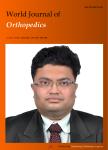Role of biomechanical assessment in rotator cuff tear repair: Arthroscopic vs mini-open approach
作者机构:Department of Basic Medical SciencesNeuroscience and Sense OrgansUniversity of Bari"Aldo Moro"Bari 70124Italy Department of Biomedical Sciences and Human OncologyUniversity of Bari"Aldo Moro"Bari 70124Italy Orthopaedic and Trauma UnitDepartment of Clinical and Experimental MedicineFaculty of Medicine and SurgeryUniversity of FoggiaGeneral HospitalFoggia 76545Italy Division of Orthopaedics and TraumatologyASST Sette LaghiDepartment of Biotechnologies and Life SciencesUniversitàdegli Studi dell'InsubriaVarese 21100Italy
出 版 物:《World Journal of Orthopedics》 (世界骨科杂志(英文版))
年 卷 期:2021年第12卷第12期
页 面:991-1000页
学科分类:0403[教育学-体育学] 1002[医学-临床医学] 100210[医学-外科学(含:普外、骨外、泌尿外、胸心外、神外、整形、烧伤、野战外)] 10[医学]
主 题:Rotator cuff tear Arthroscopic Mini-open Wearable sensors Surface electromyography
摘 要:BACKGROUND Rotator cuff(RC)tears are one of the most frequent pathologies within the shoulder *** dominance and older age are associated with RC *** different surgical procedures,the mini-open(MO)and all-arthroscopic(AA)approach,represented the standard of *** To compare the clinical and biomechanical outcomes of two surgical techniques(AA vs MO procedure)performed to address the painful shoulder syndrome with partial or total supraspinatus tendon *** Eighty-eight participants,50 following RC repair with AA and 38 with MO approach,were recruited in the present cross-sectional case-control study(ORTHO-SHOULDER,Prot.0054602).All patients underwent postoperative clinical evaluation for pain(Visual analogic scale),impairment,and disability(disability of the arm,shoulder,and hand)and limitation in daily activity(Constant-Murley score).Patients’shoulder mobility was also assessed in our Laboratory of Functional Movement through a wearable inertial sensor and surface electromyography to monitor kinematics and muscle activity during the movement on the frontal(abduction/adduction)and sagittal(flexion-extension)*** No statistically significant differences between the two procedures were observed in either main clinical score or range of motion.A significant increase in velocity during the movement execution and a higher contribution of upper trapezius muscles were found in the AA group compared with MO *** In terms of clinical scores,our findings were in line with previous ***,the use of technology-based assessment of shoulder mobility has revealed significant differences between the two techniques in terms of mean velocity and pattern of muscle activation.



